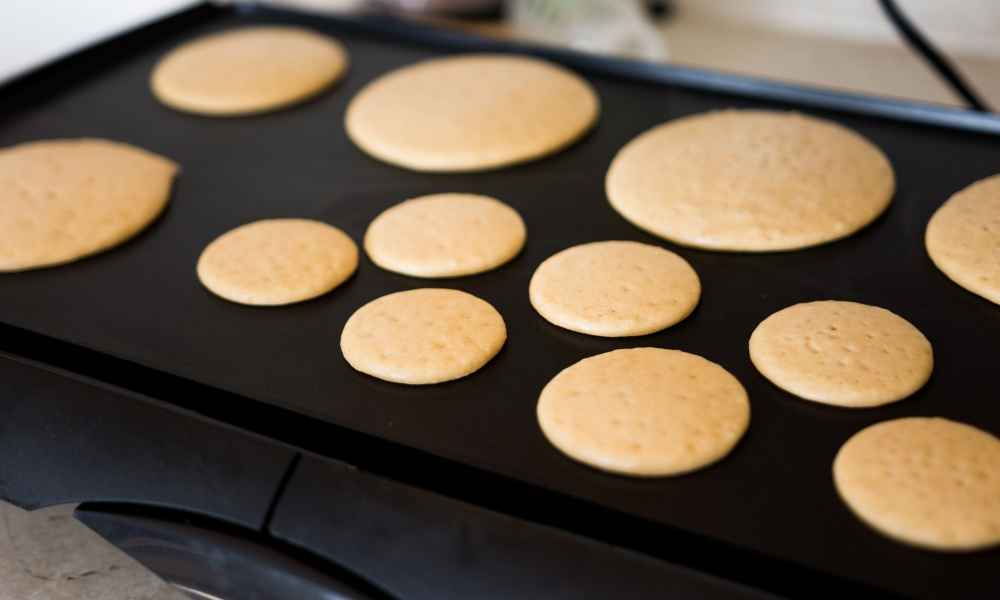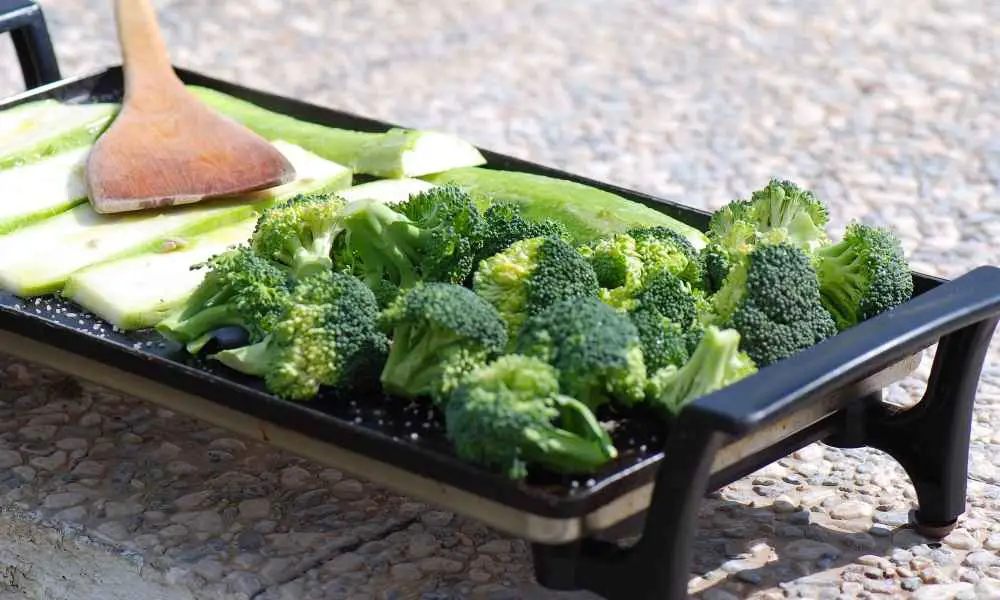Are you tired of your food sticking to your stainless steel griddle? Do you want to know how to season it properly to avoid this issue? Seasoning a stainless steel griddle is an essential step to ensure that your food doesn’t stick and that it cooks evenly. In this article, we will provide you with some simple and effective ways to season your stainless steel griddle so that you can enjoy perfectly cooked meals every time.
Seasoning a stainless steel griddle is a process of creating a non-stick surface on the griddle. This process involves heating the griddle and applying oil to it, which creates a layer of seasoning that prevents food from sticking. If you don’t season your griddle properly, your food will stick to the surface, making it difficult to cook and clean.
Whether you’re a professional chef or a home cook, seasoning your stainless steel griddle is an essential step that should not be overlooked. By following the simple steps outlined in this article, you can ensure that your griddle is properly seasoned, allowing you to cook your favorite meals without any hassle. So, let’s get started and learn how to season a stainless steel griddle.
Why Seasoning a Stainless Steel Griddle is Important
If you own a stainless steel griddle, you might be wondering why seasoning it is important. Well, seasoning is a crucial step in maintaining your griddle’s performance and longevity. Here’s why:
Prevents Stickiness
One of the main reasons to season your stainless steel griddle is to prevent food from sticking to its surface. When you season your griddle, you create a non-stick coating that makes it easier to cook and clean. Without proper seasoning, food can stick to the griddle’s surface, making it difficult to cook and leaving behind stubborn stains that are hard to remove.
Protects Against Rust and Corrosion
Another important reason to season your stainless steel griddle is to protect it against rust and corrosion. Stainless steel is resistant to rust and corrosion, but it’s not completely immune to it. Over time, exposure to air and moisture can cause your griddle to rust and corrode. Seasoning your griddle creates a protective layer that prevents air and moisture from reaching its surface, thereby reducing the risk of rust and corrosion.
Improves Lifespan
Seasoning your stainless steel griddle can also improve its lifespan. When you season your griddle, you create a protective coating that prevents the cooking surface’s material from flaking away. This, in turn, helps your griddle last longer and perform better over time. Additionally, seasoning your griddle can prevent scratches and other types of damage, which can also help extend its lifespan.
Enhances Flavor
Finally, seasoning your stainless steel griddle can enhance the flavor of your food. When you cook on a seasoned griddle, the oils and fats from the food mix with the seasoning, creating a unique flavor that can’t be replicated on an unseasoned griddle. This is especially true for foods like pancakes, eggs, and grilled sandwiches, which can benefit greatly from the added flavor that seasoning provides.
In summary, seasoning your stainless steel griddle is important for several reasons. It prevents stickiness, protects against rust and corrosion, improves lifespan, and enhances flavor. By taking the time to season your griddle properly, you can ensure that it performs well and lasts for years to come.
Choosing the Right Oil for Seasoning
When it comes to seasoning your stainless steel griddle, choosing the right oil is crucial. The oil you use will affect the taste of your food and the longevity of your griddle’s seasoning. Here are some oils to consider:
Olive Oil
Olive oil is a popular choice for seasoning stainless steel griddles. It’s a healthy oil that adds a pleasant flavor to your food. However, it has a low smoke point, which means it’s not suitable for high-temperature cooking. If you’re planning to cook at high temperatures, it’s best to avoid using olive oil.
Vegetable Oil
Vegetable oil is a neutral-tasting oil that’s suitable for high-temperature cooking. It has a high smoke point, which makes it ideal for seasoning stainless steel griddles. However, it’s not the healthiest option out there, as it’s often highly processed and contains trans fats.
Canola Oil
Canola oil is another neutral-tasting oil that’s suitable for high-temperature cooking. It has a high smoke point, which makes it a good option for seasoning your stainless steel griddle. It’s also a healthier option than vegetable oil, as it’s low in saturated fat and high in monounsaturated fat.
Coconut Oil
Coconut oil is a popular choice for seasoning cast iron pans, but it’s not recommended for stainless steel griddles. It has a low smoke point, which means it’s not suitable for high-temperature cooking. Additionally, it has a distinct coconut flavor that may not be suitable for all types of food.
High-Temperature Oil
If you’re planning to cook at very high temperatures, you may want to consider using a high-temperature oil such as peanut oil. This oil has a high smoke point, which makes it ideal for high-temperature cooking. However, it’s important to note that peanut oil is a common allergen, so it may not be suitable for everyone.
In conclusion, choosing the right oil for seasoning your stainless steel griddle is an important decision. Consider your cooking needs and preferences when choosing an oil. Remember to always use a high smoke point oil and avoid oils that have a distinct flavor that may not be suitable for all types of food.
Preparing the Griddle for Seasoning
Before you start seasoning your stainless steel griddle, you need to prepare it properly. Here are some steps you can follow to ensure that your griddle is ready for seasoning:
Clean the Griddle
The first step is to clean the griddle thoroughly. Use a non-abrasive cleaner to remove any food particles, grease, or oil from the surface of the griddle. You can also use a scraper or spatula to remove any stubborn stains.
Rinse and Dry
After cleaning the griddle, rinse it with water and dry it with a paper towel or a clean cloth. Make sure that there is no moisture left on the surface of the griddle.
Heat the Griddle
Before you start seasoning the griddle, you need to heat it up. Turn on the heat and set the temperature to high. Let the griddle heat up for about 10-15 minutes.
Add Oil
Once the griddle is heated, it’s time to add oil. You can use any high smoke point oil such as vegetable oil, canola oil, or flaxseed oil. Pour a small amount of oil on the griddle and spread it evenly using a paper towel or a brush.
Spread the Oil
Spread the oil evenly over the entire surface of the griddle. Make sure that the oil covers every inch of the griddle. You can use a paper towel or a brush to spread the oil.
Heat Again
After spreading the oil, let the griddle heat up again for about 10-15 minutes. This will help the oil to penetrate the surface of the griddle and form a protective layer.
By following these steps, you can ensure that your stainless steel griddle is properly prepared for seasoning. This will help you to achieve the best results when you start the seasoning process.
How to Season a Stainless Steel Griddle
If you have recently purchased a stainless steel griddle, you may be wondering how to season it properly. Seasoning your griddle is essential to prevent food from sticking and to enhance the flavor of your dishes. Here are the steps to season a stainless steel griddle:
Step 1: Apply Oil
The first step is to apply a thin layer of oil to the griddle. You can use any cooking oil with a high smoke point, such as vegetable oil, canola oil, or grapeseed oil. Apply the oil evenly on the surface of the griddle using a paper towel or a brush. Make sure to cover every corner of the griddle, including the sides.
Step 2: Heat the Griddle
After applying the oil, turn on the burners and heat the griddle to a high temperature. The heat will help the oil penetrate the pores of the stainless steel and create a non-stick surface. You can use a thermometer to check the temperature of the griddle. The ideal temperature for seasoning a stainless steel griddle is between 400 and 500 degrees Fahrenheit.
Step 3: Let the Oil Smoke
Once the griddle reaches the desired temperature, wait for the oil to smoke. This is an indication that the oil has reached its smoke point and is ready to bond with the stainless steel. The smoke point of the oil depends on the type of oil you are using. For instance, the smoke point of canola oil is around 400 degrees Fahrenheit, while the smoke point of grapeseed oil is around 420 degrees Fahrenheit.
Step 4: Cool the Griddle
After the oil has smoked, turn off the burners and let the griddle cool down. You can use tongs to handle the griddle as it will be hot. Once the griddle has cooled down, use a paper towel or a grill stone to remove any excess oil and debris from the surface. This will help create a smooth surface for cooking pancakes, eggs, and other dishes.
Step 5: Repeat the Process
To ensure that your stainless steel griddle is properly seasoned, repeat the above steps at least three to four times. This will help build up a layer of seasoning that will protect the griddle from rust and corrosion. Over time, the seasoning will also enhance the flavor of your dishes by infusing them with fatty acids and other nutrients from the oil.
By following these simple steps, you can season your stainless steel griddle like a pro. With a well-seasoned griddle, you can cook your favorite dishes with ease and enjoy the delicious flavor of your food.
Maintaining a Seasoned Griddle
Congratulations! You’ve successfully seasoned your stainless steel griddle and are now ready to start cooking. However, to ensure that your griddle continues to perform optimally, you need to maintain the seasoning. Here’s how you can do it.
Cleaning the Griddle
After each use, you need to clean your griddle. Use a scraper or spatula to remove any leftover food debris. Then, use a damp cloth or paper towel to wipe the griddle surface. Avoid using soap or detergent as it can remove the seasoning. If you need to use soap, use a mild dish soap and rinse it off thoroughly.
If you notice any rusting on your griddle, don’t panic. Simply scrub off the rust with a steel wool pad or a wire brush. Then, re-season the griddle.
Re-seasoning the Griddle
Over time, the seasoning on your griddle will wear off. You’ll know it’s time to re-season when food starts sticking to the surface or the griddle looks dull. Follow these steps to re-season your griddle:
- Clean the griddle thoroughly using a scraper or spatula and a damp cloth.
- Apply a thin layer of oil to the griddle surface. You can use any high smoke point oil such as vegetable oil, canola oil, or flaxseed oil.
- Heat the griddle to medium-high heat and let the oil smoke for about 10-15 minutes.
- Turn off the heat and let the griddle cool down completely.
- Wipe off any excess oil with a paper towel.
Repeat this process every few months or as needed to maintain the seasoning on your griddle.
To avoid damaging your griddle, use heat-resistant gloves or tongs when handling it. Also, avoid using metal utensils as they can scratch the surface. Instead, use wooden or silicone utensils.
In summary, maintaining a seasoned griddle is easy. Clean it after each use and re-season it every few months or as needed. With proper care, your stainless steel griddle will last for years and provide you with delicious meals.
Conclusion
Congratulations! You have successfully seasoned your stainless steel griddle. With a little bit of care and attention, your griddle will continue to provide you with delicious meals for years to come. Remember to follow these simple steps to keep your griddle in top condition:
- Clean your griddle after every use to prevent any buildup of food or grease.
- Season your griddle regularly to maintain its non-stick surface.
- Use the right tools and utensils to avoid scratching the surface of your griddle.
- Store your griddle in a dry place to prevent rusting.
By following these tips, you can ensure that your stainless steel griddle remains in top condition and provides you with delicious meals every time. Happy cooking!



